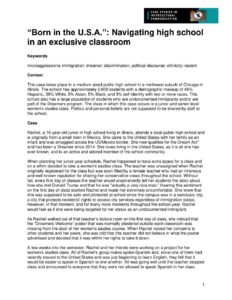“Born in the U.S.A.”: Navigating high school in an exclusive classroom
Keywords
microaggressions; immigration; dreamer; discrimination; political discourse; ethnicity; racism
Context
This case takes place in a medium sized public high school in a northwest suburb of Chicago in Illinois. The school has approximately 2,600 students with a demographic makeup of 46% Hispanic, 38% White, 8% Asian, 5% Black, and 3% self-identify with two or more races. This school also has a large population of students who are undocumented immigrants and/or are part of the Dreamers program. The class in which this case occurs is a junior and senior level women’s studies class. Politics and personal beliefs are not supposed to be shared by staff at the school.
Case
Rachel, a 16-year-old junior in high school living in Illinois, attends a local public high school and is originally from a small town in Mexico. She came to the United States with her family as an infant and was smuggled across the US/Mexico border. She now qualifies for the Dream Act* and has been a Dreamer since 2014. She loves living in the United States, as it is all she has ever known, and is an active and adored member of the school community.
When planning her junior year schedule, Rachel happened to have extra space for a class and on a whim decided to take a women’s studies class. The teacher was unassigned when Rachel originally registered for the class but was soon filled by a female teacher who had an infamous and well-known reputation for sharing her conservative views throughout the school. Without fail, every first day of classes the teacher would unashamedly tell her students the story about how she met Donald Trump and that he was “actually a very nice man.” Hearing this sentiment on the first day of class startled Rachel and made her extremely uncomfortable. She knew that she was supposed to be safe and protected at school since the campus was in a sanctuary city, a city that protects residents’ rights to access city services regardless of immigration status. However, in that moment, and for many more moments throughout the school year, Rachel would feel as if she were being targeted for her status as an undocumented immigrant.
As Rachel walked out of that teacher’s lecture room on the first day of class, she noticed that the “Dreamers Welcome” poster that was normally plastered outside each classroom was missing from the door of her women’s studies course. When Rachel voiced her concerns to other students and her peers, she was told that this teacher did not believe in what the poster advertised and decided that it was within her rights to take it down.
A few weeks into the semester, Rachel and her friends were working on a project for her women’s studies class. All of Rachel’s group mates spoke Spanish and, since one of them had recently moved to the United States and was just beginning to learn English, they felt that it would be easier to speak in Spanish to one another. All was going well until the teacher stopped class and announced to everyone that they were not allowed to speak Spanish in her class. Rachel knew that she was doing this to make things harder on her group, but she decided not to say anything. After class, Rachel and her group stood by the lockers outside of their women’s studies classroom and began to chat amongst themselves when the beginning lyrics of Bruce Springsteen’s “Born in the USA” began to trickle through the loudspeaker. This music was a normal spectacle in Rachel’s high school and often students would be accompanied to class by the wallowing chords of a broken-hearted country singer or the upbeat girl boss vocals of Lizzo. However, while the song was familiar and widely accepted, the actions of Rachel’s women studies teacher was not.
Rachel’s teacher had noticed her group congregating against the lockers and as she approached them, the teacher threw her arms in the air and started singing “Born in the U.S.A.,” dancing as she stepped. Everyone in the hallway was dumbfounded, insulted, and confused by this teacher’s actions. The previous microaggressions were off putting but manageable. However, her public display of anti-undocumented immigrant sentiment was more extreme.
Discussion Questions
As you consider this case, discuss:
- What are the power dynamics at play in this case?
- What impact did the teacher’s actions have on Rachel’s feelings of safety and belonging at school?
- How could students and teachers step in to make undocumented students feel safer at school?
- How might a student’s immigration status affect their academic experiences?
- How or when is it appropriate for teachers to bring their politics into the classroom?
- How can the school handle situations where there are differences in political opinions?
- How should the school handle the microaggressions and racism the teacher displayed?
- How can the school make immigrants and Dreamers feel more welcome?
- What should the students do as a response to this situation?
Additional Resources
Additional recommended resources to explore the central themes in this case are available.
- Ballinas, J. Where Are You From and Why Are You Here? Microaggressions, Racialization, and Mexican College Students in a New Destination, https://doi.org/10.1111/soin.12181
- Center for Racial Justice in Education, Resources for Educators and Families about Immigration and DACA, https://centerracialjustice.org/resources/resources-for-educators-and-families-about-immigration-and-daca/
- Immigration 101: What is a Sanctuary City?, https://americasvoice.org/blog/what-is-a-sanctuary-city/
- Steve Drummond, Politics In The Classroom: How Much Is Too Much?, NPR, https://www.npr.org/sections/ed/2015/08/06/415498760/the-role-of-politics-in-the-classroom
- The Dream Act: An Overview, American Immigration Council, https://www.americanimmigrationcouncil.org/research/dream-act-overview
- Whitney Grinnage-Cassidy, Why Microaggressions Aren’t So Micro, TED Talk, https://youtu.be/Z7l194OXxYo
Corresponding Author
Holtz, Kelsey. American University, USA. Email: kh7369a@student.american.edu


